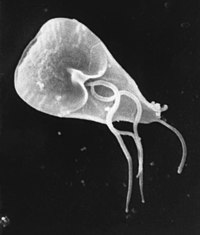
Photo from wikipedia
Abstract Background: In developing countries, diarrhoea is the most common cause of death for children under five years of age, with Giardia lamblia, Cryptosporidium and Entamoeba histolytica as the most… Click to show full abstract
Abstract Background: In developing countries, diarrhoea is the most common cause of death for children under five years of age, with Giardia lamblia, Cryptosporidium and Entamoeba histolytica as the most frequent pathogenic parasites. Traditional microscopy for stool parasites has poor sensitivity and specificity, while new molecular methods may provide more accurate diagnostics. In poor regions with sample storage hampered by uncertain electricity supply, research would benefit from a method capable of analysing dried stools. Methods: A real-time multiplex PCR method with internal inhibition control was developed for detecting Giardia lamblia, Cryptosporidium hominis/parvum and Entamoeba histolytica directly from stool specimens. Applicability to dried samples was checked by comparing with fresh ones in a small test material. Finally, the assay was applied to dried specimens collected from Guinea-Bissauan children with diarrhoea. Results: The PCR’s analytical sensitivity limit was 0.1 ng/ml for G. lamblia DNA, 0.01 ng/ml for E. histolytica DNA and 0.1 ng/ml for Cryptosporidium sp. In the test material, the assay performed similarly with fresh and dried stools. Of the 52 Guinea-Bissauan samples, local microscopy revealed a parasite in 15%, while PCR detected 62% positive for at least one parasite: 44% of the dried samples had Giardia, 23% Cryptosporidium and 0% E. histolytica. Conclusions: Our new multiplex real-time PCR for protozoa presents a sensitive method applicable to dried samples. As proof of concept, it worked well on stools collected from Guinea-Bissauan children with diarrhoea. It provides an epidemiological tool for analysing dried specimens from regions poor in resources.
Journal Title: Infectious Diseases
Year Published: 2017
Link to full text (if available)
Share on Social Media: Sign Up to like & get
recommendations!